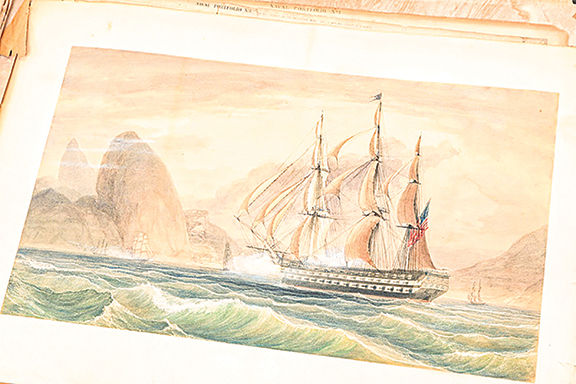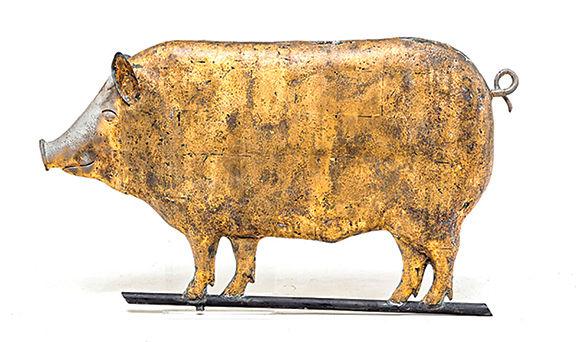62nd Annual Thanksgiving Americana Auction
- Don Johnson for Maine Antique Digest
- Mar 11, 2023
- 6 min read
Something interesting came out of the 62nd annual Thanksgiving Americana sale held by Garth’s Auctions in Columbus, Ohio, November 25—something unexpected. And it had nothing to do with any specific item being offered.
The auction was Garth’s first live event since the salesroom floor closed after the start of the pandemic. When asked about having bidders back at the historic Municipal Light Plant, Jeff Jeffers, CEO and principal auctioneer of Garth’s, responded with an astute comment.
“It was like riding a bike,” he said. “It was fun to do it live again. There’s no substitute for the satisfaction that I think the auction staff achieves or experiences with a live auction. I was concerned that a perceived small turnout would bum out my staff and those in attendance. I’m reading in every story in the trade publications about twenty bidders, thirty bidders [in attendance]. We knew that would follow through in Columbus, Ohio, and it did.
“Although it was good to be back and felt very comfortable, we missed people. We would like to have more in the room. There were twenty-eight or thirty in the room. There would be three or four times as many prior to COVID.
“But we understand the change is very likely permanent and that place has very little impact, meaning people are going to sit at home. They are going to do the convenient and comfortable thing for them. We just hope that younger and newer people stepping into this world are able at some point to understand how wonderful it can be to take a deep breath, peruse an antique mall for the afternoon with no schedule, preview an auction, attend an auction, go meet a dealer at a shop and learn something, without the stressors of the world. We see all the increase in speed driven by technology is rewiring our brains to not slow down and take a minute. Antiques are all about slowing down and taking a minute.”
And there it was—a refreshing assessment of the auction business, in part, and the antiques industry as a whole. These things people chase and throw money at provide enjoyment, but the personal connections and other benefits—the slowing down and taking a deep breath to appreciate the objects and the moment—have value that cannot be recorded on a website or discovered in one’s pajamas while cradling a laptop.
The stuff people chase can be good. The slowing down amid the hurry of that hunt can be even better.
In that way, Jeffers’s comments fit perfectly with the Thanksgiving holiday theme of the auction, which saw a surprise with the top lot, a naval portfolio that held three hand-colored lithographs by U.S. Navy Lieutenant H. Walke, large-folio prints from Naval Scenes in the Mexican War, published by Sarony & Major, New York, 1847-48. They sold with a mismatched, unsigned image of a three-masted warship flying an American flag, most likely from the same time period. The cardboard portfolio had marbleized covers and a “Naval Portfolio” label on the front. The lot realized $6875 (including buyer’s premium) against an estimate of $300/600.


Considered one of the rarest naval print series produced, the portfolio originally consisted of eight lithographs depicting activity in the Mexican War during the spring and summer of 1847, when Walke served as second in command of the U.S.S. Vesuvius. For more about this portfolio and Lieutenant H. Walke, see this online resource (www.baxleystamps.com/litho/1848090524_no4.shtml).
The artwork was initially drawn in the fall of 1847, when Walke had returned to the United States on leave. He is said to have personally created five of the lithograph stones used to make the prints, and the other three images were also based on his art.
The lithographs in the portfolio offered by Garth’s were No. 1, “The U.S. Steam Frigate Mississippi, Comre. M.C. Perry”; No. 3, cataloged as No. 4, “The U. States Steamers, Scorpion, Spitfire, Vixen and Scourge; with 40 Barges in Tow, Crossing the Bar at the Mouth of Tobasco River, (Mexico.)”; and No. 8, “The U. S. Naval Battery During the Bombardment of Vera Cruz on the 24 and 25 of March 1847.”
Each measured approximately 18¼" x 24" and had varying degrees of damage, including some notable tears and losses to the lower edges. The complete eight-print set is exceptionally scarce, and even single images are hard to find and often in poor condition. Jeffers summed up the lot by saying, “There are some objects that are going to be positively unpredictable.”
The auction’s next-highest lot was a still-life painting by Alfred Montgomery (1857-1922), depicting ears of corn in a bushel basket and others spilling from a barrel. Oil on artist’s board, the work was signed and dated 1911. Measuring 19½" x 32", the painting sold for $5040 (est. $1000/2000). Montgomery is known for his paintings of ears of corn.
“This came out of a longtime, 65-year collection deep in the Midwest, and it went to a very good collector,” Jeffers said of the artwork. “The Montgomery corn is strong.”
Following the farming theme, a full-bodied pig weathervane in copper with a cast-zinc head and tail sold for $3000 (est. $400/800). The item dated to the second half of the 20th century. Measuring 20" high x 34½" long, it had distressed gold leaf, small holes, and a seam split.

Weathervanes continue to be a folky form near the center of the field of Americana. For a while, prices had shifted to the south. Jeffers has seen a turnaround. “It strikes me that the weathervane market is holding its own. It’s come back more than some other categories,” he said. “It continues to hold true that form drives value. In a lot of ways, folk art has more upward mobility in general than Americana. Folk art, being affairs of the heart and one-offs, it really sort of pops.”
Ohio stoneware was significant throughout the day, led by a six-gallon salt-glazed stoneware churn with large cobalt script reading “Hormell & Smyth / Manufacturers / of Stoneware / Tuscarawas / Co. Ohio.” From the third quarter of the 19th century, the churn sold for $2875 (est. $600/900).
The Ohio stoneware on offer featured a mix of freehand cobalt lettering that identified the maker, impressed marks supplemented by cobalt designs, and vessels with impressed marks but no decoration.
“Because a lot of that historic production doesn’t have exuberant cobalt decoration, signed examples, trade examples, are highly collected, and makers often receive a lot of attention,” said Jeffers. Size also played a role in bidding. “These were some larger pieces.”
He noted that stoneware is attracting novice collectors. “I see some younger folks getting into this, latching onto stoneware early in their collecting. So that’s good overall.”

Other Ohio items included early glassware. A Zanesville swirl bottle in dark amber, second quarter of the 19th century, 8¼" high, sold for $2875 (est. $400/800). Jeffers described the market as stable. “Good forms and good condition are commanding competitive price. Color obviously always plays a part in the price. We get excited when it’s glass. It’s a fun category for us.”
Furniture in the sale was led by a Soap Hollow-style bed made of antique and contemporary elements and decorated by David T. Smith of Morrow, Ohio, that sold for $3750 (est. $1500/3500). A period cannonball bed was altered to a modern king size and given grain-painted and stenciled decoration.
Antique furniture included a set of six Sheraton-to-Classical transitional side chairs in mahogany, second quarter of the 19th century, that realized $2625 for the set (est. $600/1200). The chairs had pierced and carved slats and carved legs with acanthus details.
The workmanship played a role in the bidding, according to Jeffers. “They were not the very first year of Boston, New York, Philadelphia workmanship, but they were very respectable. I think when a good set appears on the market, people will still take notice and decide if they’re going to upgrade.” Numbers also mattered. “For one, two, or three [chairs], it’s kind of a dead market unless it’s a very special chair. Sets, people are willing to consider an upgrade. Good sets garner the attention of people who already have chairs, more so than another piece of furniture."
Overall, the furniture market is still trying to catch up to previous levels of interest. “Furniture in general continues to be an opportunity for buyers,” Jeffers said. “Painted things, there’s no shortage of attention there. For hardwood, brown furniture, and things with some sense of refinish, I think you’re going to sleep easier if you’re able to wrap your brain around how much value you have gotten out of using these things.”
For more information, phone Garth’s at (740) 362-4771 or visit (www.garths.com).
Originally published in the April 2023 issue of Maine Antique Digest. © 2023 Maine Antique Digest -


















Comments